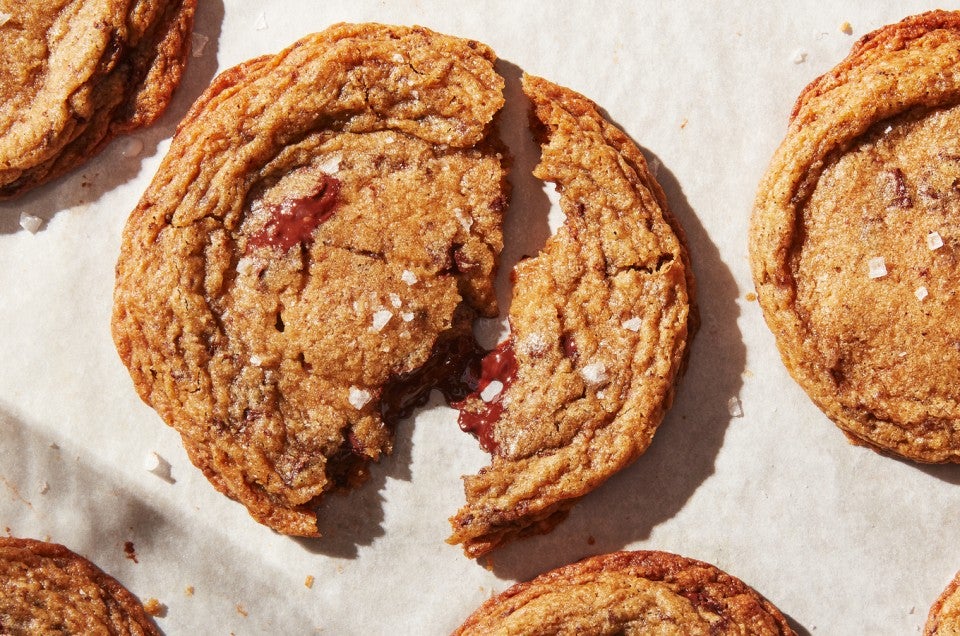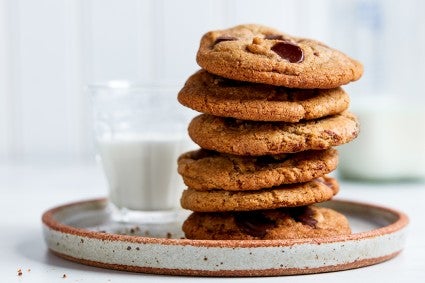The secret to fudgier cookies? It's all about the butter.
Swapping out softened butter for melted is an easy way to transform the texture of your drop cookies.


Cookies: The New Classics author Jesse Szewczyk knows a thing or two about how to make great cookies. And for anyone who wants theirs as fudgy as can be, he's sharing his go-to technique below. (Heads up: At King Arthur, we only recommend the cookbooks that we, as bakers, truly love. When you buy through external links on our site, we may earn an affiliate commission.)
* * *
I’ve baked nearly a thousand batches of cookies over the past few years — and that’s no hyperbole. My first cookbook (aptly titled Cookies) included 100 different recipes ranging from snickerdoodles to shortbread. I spent countless days baking cookies, adjusting bake times, ingredients, and processes until the finished product came out just right.
This formulaic approach to cookie baking made me look at them differently. Now when I eat a cookie, I notice when it’s made with shortening versus butter, when the dough would have benefited from resting in the fridge, and if it was over- or under-mixed. But one of the most obvious details I now pick up on is when a cookie is made with melted butter versus creamed butter. This might sound like a rather minor detail, but the change in texture is significant, and it’s one I don’t think is talked about enough.

Creaming softened butter and sugar together incorporates air into the dough, helping cookies rise, puff up, and become lighter as they bake. Traditional wisdom suggests that failing to do so results in cookies that are dense — but what if you want your cookies to be dense?
I’ve always been a fan of cookies that are rich and fudgy in the center, so the idea of forgoing the creaming process made sense to me. About halfway through writing Cookies, I started using melted butter instead of creaming it. By switching up the technique, I omitted all the extra air that gets incorporated into the dough during creaming, and as a result, the cookies made with melted butter were significantly chewier and fudgier than those made with creamed butter.
Think of it this way: Brownies and blondies both have an amazing dense texture — not raw or undercooked in the center, but legitimately fudgy. These treats are almost always made with melted butter, omitting that extra rise that comes from creamed butter. Using melted butter in cookies helps you achieve a similar fudgy-yet-cooked texture and prevents any unwanted cakiness.
Instead of the rise coming from both chemical and physical leavening agents (baking soda/powder + creamed butter), it now comes almost exclusively from chemical agents alone. Chemical leavening agents help the cookies rise and puff in the oven but are not necessarily strong enough to prevent cookies from deflating once they hit a certain threshold of puffiness. Cookies made with melted butter often deflate and become denser when they cool, resulting in a perfectly cooked fudgy center — a similar textural result to brownies that get rapped (aka banged against an oven rack mid-bake to deflate them) or Sarah Kieffer's iconic pan-banging cookies that turn out pleasantly compact.

Melted butter is best suited for drop doughs such as chocolate chip, peanut butter, and sugar cookies, as well as most cookie bars. You can usually adapt recipes that don't originally call for melted butter to use this technique if you're looking for an even fudgier texture.
To do so, use the same amount of butter called for in the recipe and melt it until just liquified but not browned. Combine that with your sugar and proceed with the recipe as written. (One bonus: Melted butter is a lot easier to mix into sugar by hand.) Because melted butter is warmer, the dough might require an hour or two of chilling in the fridge to prevent the cookies from spreading too much in the oven. (I always recommend baking off one test cookie in the oven before committing to baking the whole batch, especially when tweaking recipes for the first time.)
If done properly, your cookies should come out slightly fudgier and more compact, with a crisp-on-the-edges, soft-in-the-center texture that bends instead of snaps.
If you're a fan of cakey cookies, or love a cookie with a delicate lightness, this technique probably isn't for you. Omitting the air from the creaming process will result in a significant loss of rise. But if, like me, you love rich, decadent cookies with a pleasantly dense center, using melted butter might just be your new go-to technique. Consider this permission to break the antiquated creamed butter-only rules of the past and make the cookie you truly want.

Rye Chocolate Chip Cookies: Any variation of chocolate chip cookies is prime for using melted butter. This version, made with nutty rye flour, is a great example of how melted butter can make the centers pleasantly gooey without being undercooked.
Chewy Chocolate Chip Cookie Bars: Using melted butter in cookie bars helps give them that wonderful brownie-like texture that’s crisp on the edges and moist in the center.
Chocolate Chocolate Chip Cookies: While this recipe calls for using softened butter, it's a prime example of a cookie that could be adapted to be made with melted butter. Doing so will lean into the brownie qualities of the cookie and make the centers even fudgier. Just make sure to bake off a test cookie to make sure the dough doesn't need to be chilled first. If the test cookie spreads too much, chilling the dough for one hour will do the trick.
Cover photo (Buckwheat-Cardamom Chocolate Chunk Cookies) by Rick Holbrook.

